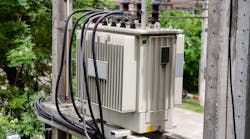‘Resilience’ is a concept that’s enjoying something of a renaissance. To us Brits, it conjures images of the stiff upper lip and ‘keep calm and carry on,' but all around the world resilience is coming to the fore as a crucial characteristic for our infrastructure, businesses, cities and societies.
It makes sense: climate change brings us more extreme weather events, growing urban populations place additional strain and importance on infrastructure and a cut-throat as ever commercial environment means businesses can’t afford downtime. Resilience captures the importance of both preventing and bouncing back from catastrophes.
One sometimes overlooked key aspect of both is the power transformer, and specifically the transformer fluid that goes into it.
Transforming resilience
Transformers are a crucial part of electricity infrastructure. They help keep the lights on, keep the production lines running, the hospitals open.
As more grid connections at transmission and distribution level put strain on our aging grid, it is now more important than ever that utilities ensure their transformers operate efficiently and without risk of fire.
Transformer fires can be violent and deadly, especially in densely populated areas. There’s a reason why no transformer can be within 2km of the Taj Mahal.
So one facet of resilience is to prevent transformers going awry, and to make them less dangerous if and when they do. Here, ester fluids can help.
As an alternative dielectric fluid to mineral oils, esters have far higher flame points. So, if something does go wrong they are much less likely to catch fire.
Ester fluids can also make a transformer more robust by extending asset life and making it healthier. As a healthy person is better able to fend off illness, so a healthy transformer is better able to cope with the strain of extreme or atypical conditions. As intermittent renewables increase peakiness of power and the electrification of heat and transport increases the load exponentially, transformers that can keep up will be vital assets for utilities.
Bouncing back
But not all catastrophe can be avoided, and resilience is also about bouncing back. Extreme weather events, terrorist attacks or other disasters can all knock transformers out of action. This can increase both misery and loss of life in the case of humanitarian disasters, and heavily impact revenue for business ones. End customers look to their utility provider to restore power as quickly as possible.
Again, ester fluids can bolster resilience.
It is possible to make much smaller transformers when specifying ester fluids. Some can be as small as 500 tonnes – potentially a third of standard. This can make all the difference: it can, for example, be the difference between loading onto a truck and crossing bridges and not. Some utilities have thus been able to load emergency transformers onto trailers, ready to go in case of emergency to get crucial services back online rapidly. In other words, ester fluids have enabled resilience transformers as an emergency service.
Resilience is more than a buzzword for grid. It’s an increasingly necessary part of civil and business life. Just look at the growing trend for major cities to hire dedicated Chief Resilience Officers (CROs). There are countless things that go into making a city, society or infrastructure resilient and some will be more obvious than others. However, just because they lack the visibility of say – flood barriers – for example, don’t doubt that ester fluids are a great boon to resilience.


